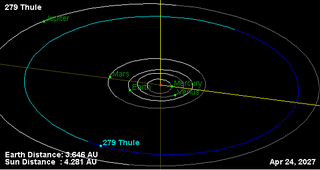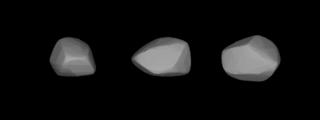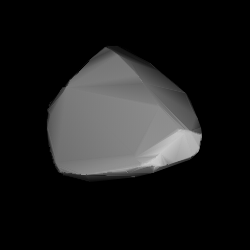
Thule, minor planet designation: 279 Thule, is a large asteroid from the outer asteroid belt. It is classified as a D-type asteroid and is probably composed of organic-rich silicates, carbon and anhydrous silicates. Thule was the first asteroid discovered with a semi-major axis greater than 4 AU. It was discovered by Johann Palisa on 25 October 1888 in Vienna and was named after the ultimate northern land of Thule.

Pierretta is a 46 km main-belt asteroid discovered on 28 Aug 1891 by Auguste Charlois at Nice.

Desiderata is a very large main-belt asteroid. It is classified as a C-type asteroid and is probably composed of carbonaceous material.

Apolonia is a large Main belt asteroid. It was discovered by Auguste Charlois on 8 March 1893 in Nice.

373 Melusina is a large Main belt asteroid. It is classified as a C-type asteroid and is probably composed of carbonaceous material. It was discovered by Auguste Charlois on 15 September 1893 in Nice.

388 Charybdis is a very large background asteroid, approximately 125 kilometers in diameter, that is located the outer region of the asteroid belt. It was discovered by French astronomer Auguste Charlois at the Nice Observatory on 7 March 1894. The carbonaceous C-type asteroid has a rotation period of 9.5 hours. It is probably named after Charybdis, a sea monster in Greek mythology.

Wilhelmina is a large Main belt asteroid.

Persephone is a main belt asteroid. It was discovered by German astronomer Max Wolf on 23 February 1895 in Heidelberg.

Arsinoë, minor planet designation 404 Arsinoë, is a large main-belt asteroid. It is classified as a C-type asteroid and is probably composed of carbonaceous material.

Arachne is a large Main belt asteroid. It is classified as a C-type asteroid and is probably composed of carbonaceous material. It was discovered on 13 October 1895, by German astronomer Max Wolf at Heidelberg Observatory.
Fama is a typical main belt asteroid in orbit around the Sun. It was discovered by German astronomer Max Wolf on 13 October 1895 in Heidelberg.

Suevia is a typical Main belt asteroid. It is classified as a K-type/S-type asteroid.
Pythia is a typical Main belt asteroid.

Cremona is a minor planet orbiting the Sun.
Messalina is a minor planet, specifically an asteroid orbiting primarily in the asteroid belt. It was discovered on 3 October 1904 by Paul Götz, at Heidelberg. It is named after Valeria Messalina, the third wife of Roman Emperor Claudius.
623 Chimaera is a minor planet, specifically an asteroid orbiting in the asteroid belt.

643 Scheherezade is a minor planet orbiting the Sun. It was named after the fictional storyteller Sheherazad.

662 Newtonia is a minor planet, specifically an asteroid orbiting mostly in the asteroid belt.

875 Nymphe is a minor planet orbiting the Sun. It is a member of the Maria family of asteroids.
935 Clivia belongs to the Flora family of Main Belt asteroids. Its diameter is about 7.9 km and it has an albedo of 0.197 .















